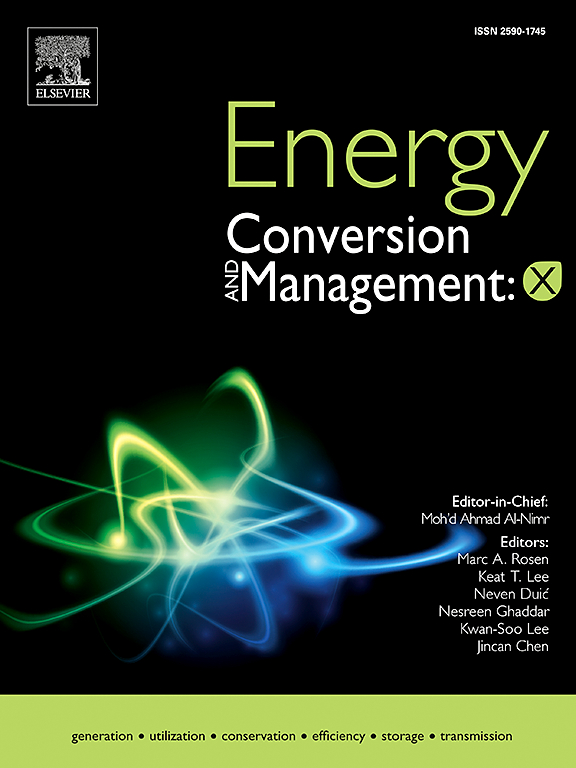Experimental and numerical study on radiative cooling of a linear alternator in a free-piston Stirling electric generator
IF 7.1
Q1 ENERGY & FUELS
引用次数: 0
Abstract
Heat rejection of a linear alternator (LA) plays a pivotal role in achieving high performance and a long lifetime. This paper proposes an innovative approach for the first time that utilizes a high emissivity coating formulated from a blend of microsilica and graphene nanosheets to enhance the radiation heat dissipation inside the LAs, offering advantages of structural simplicity and cost-effectiveness. To elucidate the radiative heat transfer characteristics interacted with the oscillating flow within the LA, firstly, a CFD model was developed to analyse the oscillating flow coupled radiative heat transfer within a 1.5-kW LA. The effects of coating emissivity, backdrop temperature, dissipated heat by the components, and mean pressure on the heat transfer of the LA’s electromagnetic components were investigated. Numerical calculations indicate that the high emissivity coating reduces the average temperature of the coil adjacent to the permanent magnet, the permanent magnet itself, and the inner stator by approximately 10.0 K, while the temperature of the coils adjoining the outer housing and the outer stator decreases by about 4.2 K. Additionally, the efficacy of the high emissivity coating in enhancing the cooling of these components was significantly amplified under elevated heat generation conditions. Subsequently, an experimental test rig was built and the results showed that the high emissivity coating reduces the temperature of the coil and outer stator by 1.1 K and 0.2 K, respectively, increases the output electric power by 6.6 W, and improves thermal-to-electric efficiency by 0.3 % under the operating conditions with cooling water temperature of 298 K and mean pressure of 4.5 MPa. This work provides valuable perception into enhancing the internal cooling effect of LAs.
自由活塞斯特林发电机直线交流发电机辐射冷却的实验与数值研究
线性交流发电机(LA)的散热在实现高性能和长寿命方面起着关键作用。本文首次提出了一种创新的方法,利用由微二氧化硅和石墨烯纳米片混合而成的高发射率涂层来增强LAs内部的辐射散热,具有结构简单和成本效益的优点。为了阐明与振荡流动相互作用的辐射换热特性,首先建立了1.5 kw LA内振荡流动耦合辐射换热的CFD模型。研究了涂层发射率、背景温度、组件散热量和平均压力对LA电磁组件传热的影响。数值计算表明,高发射率涂层使靠近永磁体的线圈、永磁体本身和内定子的平均温度降低了约10.0 K,而靠近外壳和外定子的线圈的温度降低了约4.2 K。此外,高发射率涂层在提高产热条件下对这些部件的冷却效果显著增强。实验结果表明,在冷却水温度为298 K、平均压力为4.5 MPa的工况下,高发射率涂层可使线圈和外定子温度分别降低1.1 K和0.2 K,输出功率提高6.6 W,热电效率提高0.3%。这项工作为提高激光激光器的内部冷却效果提供了有价值的认识。
本文章由计算机程序翻译,如有差异,请以英文原文为准。
求助全文
约1分钟内获得全文
求助全文
来源期刊

Energy Conversion and Management-X
Multiple-
CiteScore
8.80
自引率
3.20%
发文量
180
审稿时长
58 days
期刊介绍:
Energy Conversion and Management: X is the open access extension of the reputable journal Energy Conversion and Management, serving as a platform for interdisciplinary research on a wide array of critical energy subjects. The journal is dedicated to publishing original contributions and in-depth technical review articles that present groundbreaking research on topics spanning energy generation, utilization, conversion, storage, transmission, conservation, management, and sustainability.
The scope of Energy Conversion and Management: X encompasses various forms of energy, including mechanical, thermal, nuclear, chemical, electromagnetic, magnetic, and electric energy. It addresses all known energy resources, highlighting both conventional sources like fossil fuels and nuclear power, as well as renewable resources such as solar, biomass, hydro, wind, geothermal, and ocean energy.
 求助内容:
求助内容: 应助结果提醒方式:
应助结果提醒方式:


